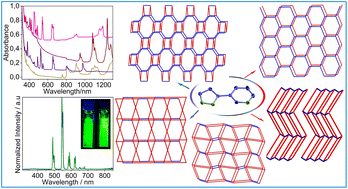3D-Frameworks and 2D-networks of lanthanide coordination polymers with 3-pyridylpyrazole: photophysical and magnetic properties†
Abstract
A series of 15 lanthanide-containing coordination polymers, both 3D- and 2D-networks, as well as complexes of Ln-trichlorides with 3-(3-pyridyl)pyrazole (3-PyPzH), were synthesized. A large structural diversity is observed depending on the ligand content: 3∞[Ln(3-PyPzH)Cl3], Ln = Eu and Gd, of sra topology, 2∞[Sm(3-PyPzH)Cl3], 2∞[Ln2(3-PyPzH)3Cl6]·2solv, Ln = Eu3+, Tb3+, Dy3+, Ho3+ and Er3+, solv = Tol and MeCN, of sql topology and 2∞[Ln(3-PyPzH2)Cl4], Ln = La and Nd, of hcb topology with salt like complexes of the formula [(3-PyPzH2)][Ln(3-PyPzH)2Cl4], Ln = Eu, Tb, Dy and Ho. The products were characterized by single-crystal and powder X-ray diffraction, high-temperature X-ray diffraction, differential thermal analysis and thermogravimetry (DTA/TG) combined with mass spectrometry, differential scanning calorimetry (DSC), IR-spectroscopy, UV–visible spectrophotometry, photoluminescence spectroscopy, and magnetic susceptibility. Absorption spectroscopy shows ion-specific 4f–4f transitions that can be assigned to Sm3+, Eu3+, Dy3+, Ho3+ and Er3+ in a wide range from the UV-VIS to NIR region. An excellent antenna effect through ligand–metal energy transfer was observed in 2∞[Tb2(3-PyPzH)3Cl6]·2solv, leading to high efficiency of the luminescence indicated by a quantum yield up to 76%. Direct current magnetic susceptibility studies reveal the absence of interatomic interaction for Dy3+ and Er3+ and weak ferromagnetic interaction for Ho3+. Thermal analysis shows good stability up to 365 °C for 2∞[Ho2(3-PyPzH)3Cl6]·2MeCN.



 Please wait while we load your content...
Please wait while we load your content...